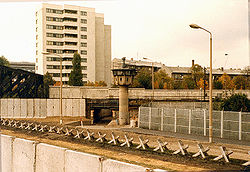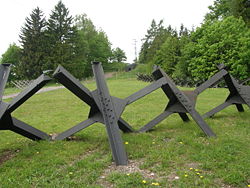- Czech hedgehog
-
 Entry point of the West Berlin S-Bahn into East Berlin near the Berlin Wall in Liesenstrasse/Gartenstrasse, 1980
Entry point of the West Berlin S-Bahn into East Berlin near the Berlin Wall in Liesenstrasse/Gartenstrasse, 1980
The Czech hedgehog (Czech: rozsocháč) or ježek, was a static anti-tank obstacle defence made of angled iron (that is, lengths with an L- or H- shaped cross section) deployed during World War II by various combatants.
The hedgehog is very effective in keeping tanks from getting through a line of defence. It maintains its function even when tipped over by a nearby explosion. Although it may provide some scant cover for infantry, infantry forces are generally much less effective against fortified defensive positions than mechanized units.
Contents
History
The Czech hedgehog's name refers to its origin in what is now the Czech Republic. The hedgehogs were originally used on the Czech-German border by the Czechoslovak border fortifications - a massive but never-completed fortification system built on the eve of World War II by Czechoslovakia. The fortification system fell to Germany in 1938 after the occupation of the Sudetenland as a consequence of the Munich Agreement.
Czech hedgehogs were widely used during World War II by the Soviet Union in anti-tank defence. They were produced from any sturdy piece of metal and sometimes even wood, including railroad ties. Czech hedgehogs were especially effective in urban combat, where a single hedgehog could block an entire street. Czech hedgehogs thus became a symbol of "defence at all cost" in the Soviet Union; hence the memorial to Moscow defenders, built alongside M-10 in 1966, is composed of three giant Czech hedgehogs.
However, in some forms of warfare, Czech hedgehogs proved to be less effective. They were often made larger than they should have been, and although they were quite useful in urban warfare, there was little use of German armour in urban warfare in Russia.
Czech hedgehogs were part of the defences of the Atlantic Wall and are visible in many images of the Normandy invasion.
Technical details
Technically, a Czech hedgehog made to specifications could be constructed from any material capable of withstanding at least 60 tonnes-force (600 kN), while being at most 1.4 metres (4 ft 7 in) high. However, such parameters were hard to achieve in makeshift hedgehogs, reducing their usefulness.
The hedgehog is not supposed to be an immovable obstacle because of its size or weight. The proper size is to be slightly larger than the clearance under the enemy tank, so that a tank that attempts to move the hedgehog would instead roll on top of the hedgehog and get stuck. [1]
Industrially manufactured Czech hedgehogs were made of three L-shaped metal brackets (L 140/140/13 mm, length 1.8 metres (5 ft 11 in), weight 198 kilograms (440 lb); later versions: length 2.1 metres (6 ft 11 in), weight 240 kilograms (530 lb)) joined by sheet metal, rivets and bolts (or, later in the war, welded together) into a characteristic spatial three-armed cross. (This pattern forms the axes of an octahedron.) Two arms of the hedgehog were connected in the factory, while the third arm was connected on-site by an M20 bolt. The arms were equipped with square "feet" to prevent sinking into the ground, as well as a notch for attaching barbed wire.
During the Normandy Invasion the allies cut up several hedgehogs and welded them to the front of M4 Sherman tanks and M5 Stuart tanks. Known as the Rhino tank it proved very useful for clearing the hedgerows that made up the bocages across Normandy.
See also
References
External links
- "Imperial War Museum Online Collection". Photograph number A 23992, Royal Navy Commandos at La Riviere preparing to demolish two of the many beach obstacles (image). http://www.iwmcollections.org.uk/qryPhotoImg.asp. Retrieved 2007-04-17.
Categories:- Anti-tank obstacles
- Area denial weapons
Wikimedia Foundation. 2010.


